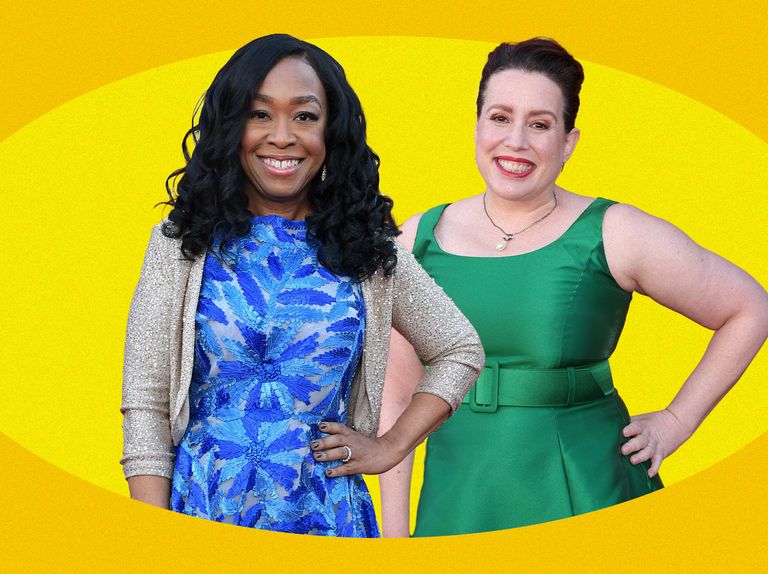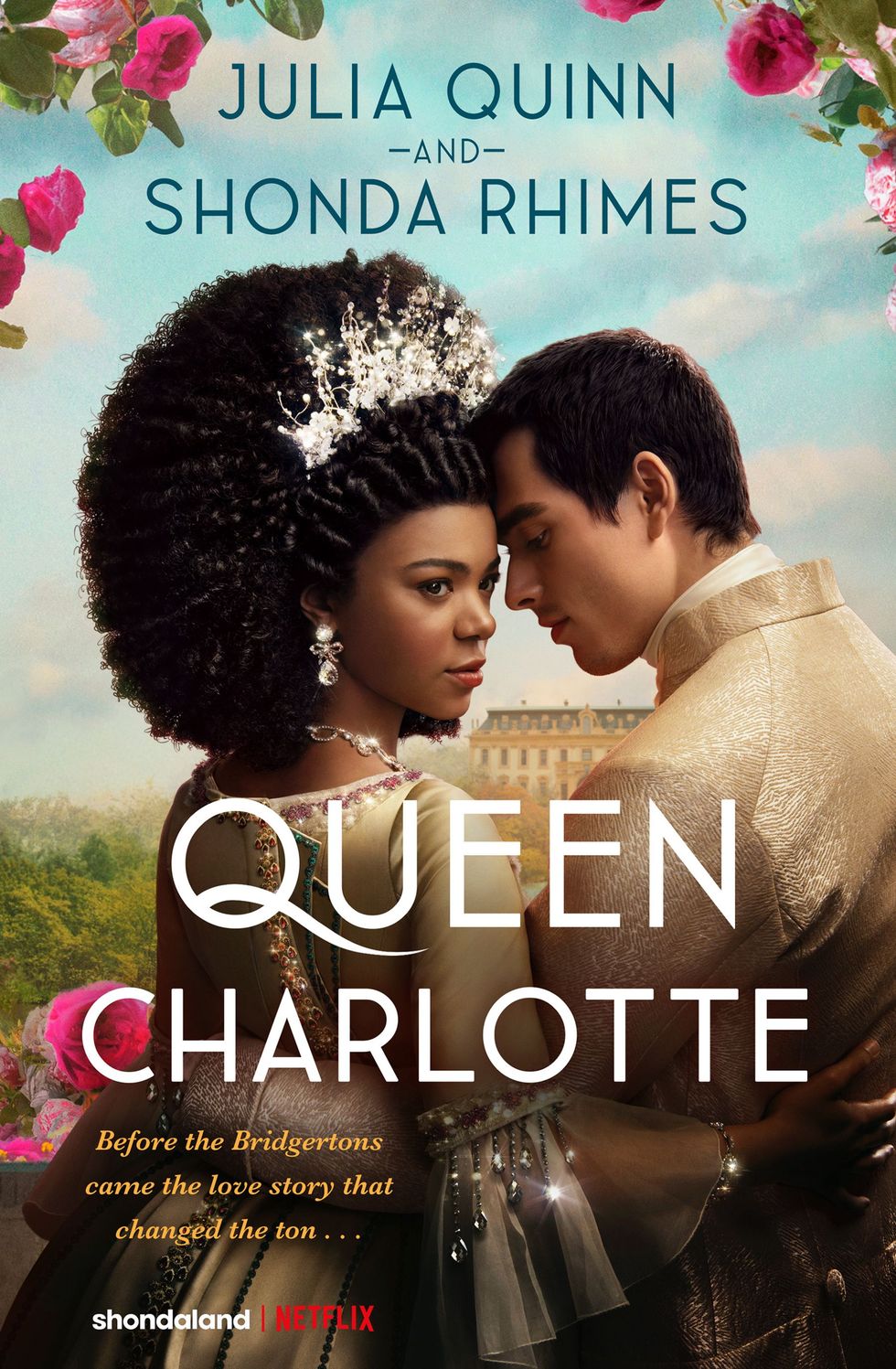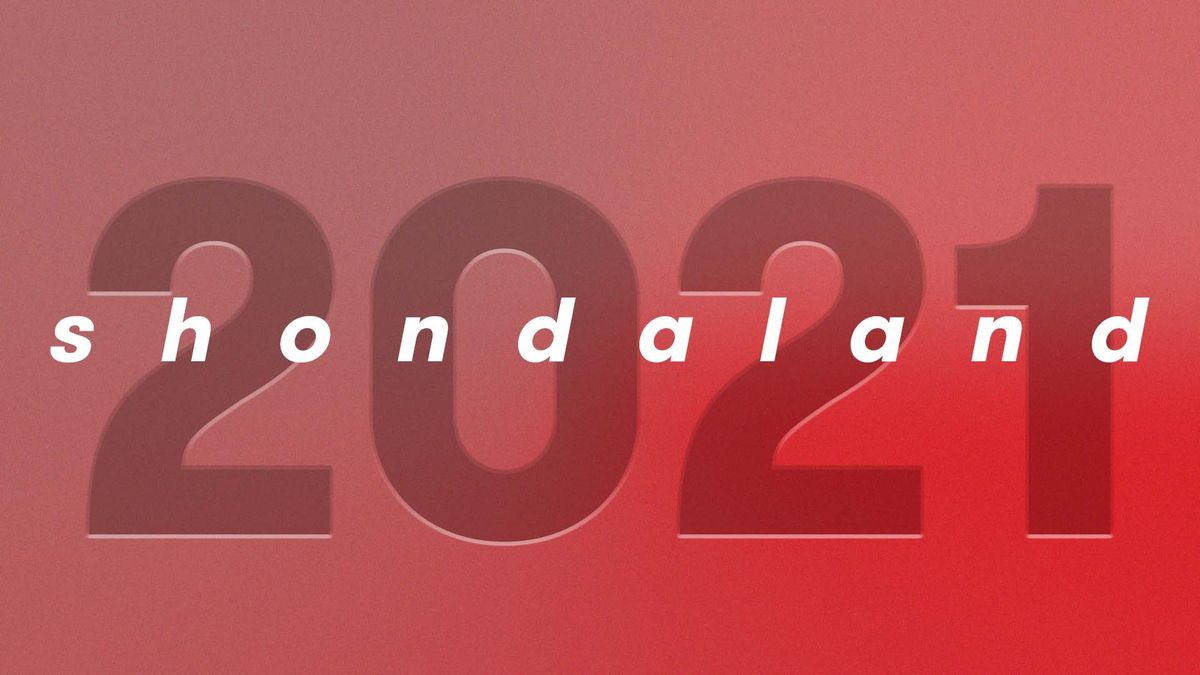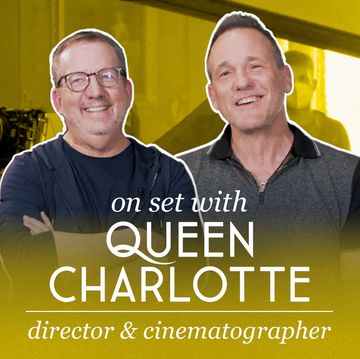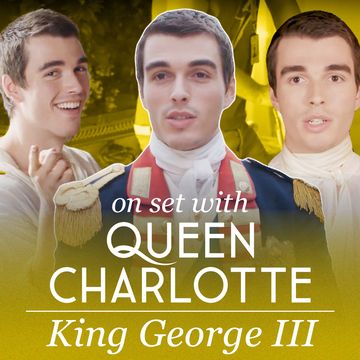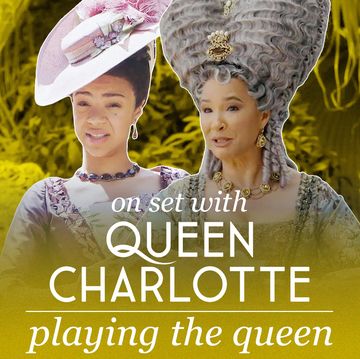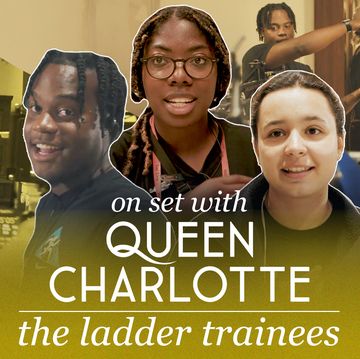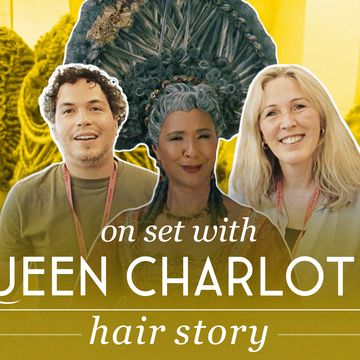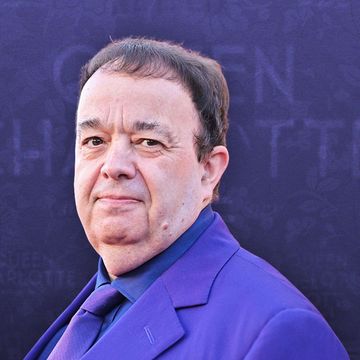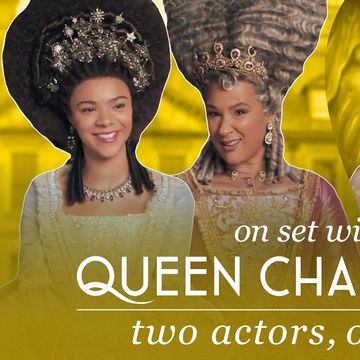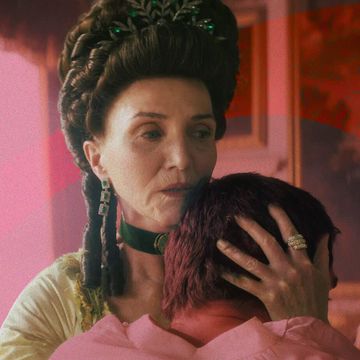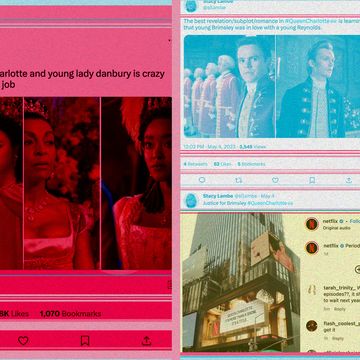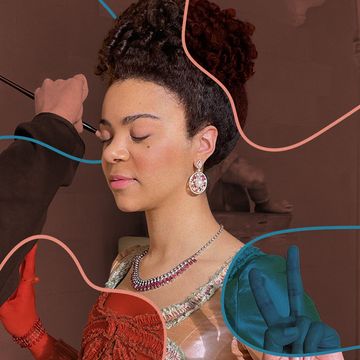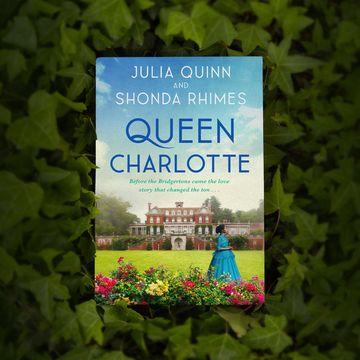If using the phrase “It was meant to be” feels corny or hyperbolic, well, friends, corny and hyperbolic is what we’ll have to be. Because to hear how Queen Charlotte, the companion book of Shondaland’s hit Netflix prequel series Queen Charlotte: A Bridgerton Story (the first chapter of which you can read here), came into existence is like reading the most serendipitous of meet-cutes in a romance novel. And it all started on the most magical of Hollywood locales, the red carpet, where Netflix’s Bridgerton executive producer, Shonda Rhimes, posed for photos with the author of the Bridgerton novels that inspired the series, Julia Quinn.
“We almost pitched each other,” says Rhimes, reminiscing about the second-season premiere of Bridgerton. “Julia basically just said, ‘It would be really cool to write a book of this,’” she continues, referring to the already planned Queen Charlotte prequel series that would tell the story of the young queen and how she came to prominence and power alongside her husband, young King George. “And I was shocked because I had wanted to do a book but had been terrified to ask Julia because I was like, no way she’s going to want to do this.”
“Oh,” says Quinn, who joined Rhimes for a Zoom with Shondaland prior to the book’s release on May 9. “I didn’t know that part!”
It turns out that Rhimes had been talking about the idea for the novel for months with Sandie Bailey, Shondaland’s Chief Design and Digital Media Officer. And as soon as Quinn mentioned the idea on that red carpet, everything fell into place.
Having never actually appeared in Quinn’s original books, the character Queen Charlotte was created to build out Shondaland’s on-screen world of Bridgerton. In the first two seasons of the series, the queen, played by the indelible Golda Rosheuvel, has seen fabulous growth, becoming a fan favorite for her fashion, her glorious hairstyles, and her unwavering ability to hold down the throne while facing adversities both personal and public. And now, in the new Queen Charlotte series and book, we can go deeper into her backstory, reveling in the early romance between young Queen Charlotte and young King George, as well as learn how this woman helped change the very institution that she was beholden to.
Both Rhimes and Quinn admit that they were super-excited at the prospect of re-creating the show in book form, and within a couple of months, the ball was rolling on what would be a first for both writers. As the Queen Charlotte novel hits shelves today, what better time to talk with Rhimes and Quinn about how they wrote the book, translating script to screen, what they left out and why, and what they learned from the process?
VALENTINA VALENTINI: Writing for TV is very different from writing prose fiction, so how did you both, in your own ways, navigate that translation?
SHONDA RHIMES: Julia had the hardest part of that translation because she had to take all the visual, silent stuff, all the work that the actors brought to the script, which the script is just a blueprint, and turn that into a real character study.
JULIA QUINN: It’s kind of what you find in the perfect elementary school best friendship — we took turns. We weren’t holed up in a room together, as fun as that would be, but rather Shonda did her part and handed it off to me, and then I did my part. While I was doing my part, I sent it back to her to make sure I was following her vision, but it was really taking turns and doing what we each do best. In many ways, it was just the reverse of the Bridgerton experience. I handed off these novels, and I said, “You know what you’re doing; go do your thing.” So, I was honored that Shonda felt the same way. She handed the scripts to me and said, “You know what you’re doing; go do your thing.”
SR: It was great to have something that I wrote turned into something by the author whose books I love so much. It all felt like a magical process to me.
JQ: Now you know how I felt about the show!
VV: How did the process begin?
JQ: I got four scripts and two outlines to start. We were on a time crunch, so I started writing the book. I sent it to Shonda when I was about halfway through, just to make sure I wasn’t completely off base.
SR: When I got that first half, it was wonderful to be able to give it back with, like, zero notes.
JQ: There were a couple notes [laughs]. But I was so appreciative because part of what I was most mindful of is wanting to capture the spirit of certain themes that Shonda had in the scripts. Like how the show is not about race — it touches on it, and that’s an important theme — but I really wanted to follow her lead on how she handled it because she can speak to it in a way that I can’t. Like, how deeply was she getting into it? Is it with a light touch here, and a heavy touch there? And there were a few notes I got back on Herman [Lord Danbury] — she felt I needed to rework him a little bit.
SR: Oh yeah, it was about understanding the sympathy. I remember we talked about that because, on the page, you sort of hate Herman. Agatha [Lady Danbury] treats him with both an exasperation and a tenderness that would only happen because she understood the plight of a Black man being in a world in which he’d never been given his due. We had really interesting conversations about that. It was great.
JQ: It was very interesting because Agatha hates him; she really does. She really doesn’t like this person, but she has sympathy for him. And Shonda was helpful in helping me understand where she’s coming from with that.
VV: What were the challenges in writing this book?
JQ: The biggest challenge was doing this type of reverse engineering. Film and television have a structure, like that type of writing has many short scenes. And novels have a different structure. I got a taste of what folks at Shondaland have to do when they’re trying to take a Bridgerton novel, and break the structure down, and then rebuild it into a television structure. So, I had to break down the architecture of the show and rebuild it in a different way. And I really enjoyed it because I’m a puzzle person. I had all these short scenes, and I had to figure out whose point of view each scene would be from, and then had to move them around in order to fit together. There were places where maybe one scene ends up in a different place, so things have to be rearranged a little. The puzzle part of it was definitely the biggest challenge but also the most fun.
SR: Honestly, it was an education for me watching this process happen because I don’t think I realized how much I depend on the actors to bring the other half of the story in. I write these scenes, and I’m like, “Oh, we’ll figure it out on set.” It was so interesting realizing that you have to figure it all out, every single piece, in order for a novel to work.
JQ: The most fun was getting into Agatha’s head because her inner person is pretty sarcastic. And to write out what she was thinking was fun. Another really fun thing I got to dig into was the “even days” thing [in which Charlotte and George are fighting but still need to have sex every other day to try and make an heir]. When I went to set in July of last year, I asked Tom Verica if he knew where even days comes from. And he said, “Somewhere in Shonda’s head!” And I thought it was so cool that I got to invent how they came up with even days, like that could be a fun scene that I get to write. It turned out to be a very rom-com scene, which was great to be able to put some of that in the book because the show is very much not a rom-com. It enabled me to bring more of a traditional romance arc to the story. Even though it’s not a romance novel in the way my other books are, I wanted to have that satisfying romance sense wherever I could.
VV: Shonda, was there anything you told Julia that couldn’t be changed from script to book?
SR: I don’t think that came up because Julia was a meticulous translator in that way. It wasn’t that every scene had to be exactly how it had been in the script; it was that the themes from the show resonated and were real in the book. Also, I think this is funny — the Bridgerton shows are sexy because the books were sexy. In Queen Charlotte, I didn’t write sexy scenes with tons of detail; we want the actors to do whatever the actors feel comfortable with, and this is what we’re trying to convey. And then Julia had to turn those scenes into true romance novel, sexy, full, complex scenes that conveyed character, and you did an amazing job.
JQ: Thank you! You know, the funny thing is that people are always saying Bridgerton books are so sexy, but within the romance book world, I’m not known as a particularly steamy writer! And personally, I don’t think the Bridgerton show is particularly steamier than half the stuff on television. I think it’s just because it’s told in a different way, there’s so much more of the female point of view, it’s presenting sex and intimacy as something not transactional, not a conquest. And so much of the media doesn’t have the language for that yet, so instead, they’re just like, “It’s Bonkerton!”
SR: [Laughs] I think you’re right.
JQ: It’s annoying, but maybe it’ll get more normalized someday.
SR: I know it was a big deal with the whole female gaze thing. And with Queen Charlotte, it was great to be able to show the female point of view of bad sex with [Agatha and Herman], how a woman interpreted, at that period of time, “I’m not enjoying this at all, so I’m gonna think about something else.” And it was great to then juxtapose it against this very sensual relationship between Charlotte and her husband.
JQ: One thing I really appreciated in the script, which you wouldn’t see if you haven’t read the script, but Shonda was very careful to point out in the script that it’s not assault, what’s happening. It was just, “She is not into it.”
SR: It was of its era. You know what I mean? This is what most men have been raised to think sex is. It wouldn’t occur to him that she should be enjoying it. That’s not in his encyclopedia of how to treat women. And it wouldn’t occur to her that she’s supposed to ask for something different. So, I loved playing that sort of sexual awakening for her. And you know, there are aspects to Agatha’s arc that I thought were really interesting and that affect the Bridgerton storylines, because we see those women in both eras, but that we chose not to put in the book because it didn’t enhance the story in an interesting way. It only enhanced the story for the next time you were going to watch Bridgerton, in a weird way.
VV: What parts of the show don’t make it into the book?
JQ: In the book, the whole arc with Violet’s father, Lord Ledger, isn’t in there. That storyline was the most connected with the storyline that was happening in the Bridgerton present era, and in so many ways, those two were already so intertwined. Plus, I’d already made the decision to not move back and forth between the eras — it just doesn’t work in a novel, and it would’ve made it so long. With just doing the Georgian era portion, I had a hundred thousand words almost. And moving back and forth is distracting in a book in the way that it’s not in a television show. So, having already decided to focus on that earlier time period, I just realized that you still have a huge character growth arc for Agatha without Lord Ledger.
VV: So, the book doesn’t jump back and forth at all, not even to show Queen Charlotte’s kids and the whole trying to produce another heir?
JQ: No. It’s bracketed by two very short scenes at the beginning and end in Bridgerton present time, but otherwise it’s set in the earlier time.
VV: That’s a really big change from the series.
SR: It is. I was very caught up in this idea of Queen Charlotte being determined to further her line — getting pregnant with Queen Victoria, basically. But I don’t think it was needed to enhance the book. The book’s story is really its own. It’s not a novelization; it’s a novel. So, the goal was to tell the stories as they needed to be told for the book and to tell the stories as they needed to be told for the show.
VV: Shonda, when I talked to the show’s historical consultant, Polly Putnam, she said that you really did your homework and was very impressed with how much you already knew. [add a link to Shondaland’s recent interview with Polly Putnam?]
SR: I’m a huge history buff, and in every story I’m telling, I like to dive into a world and learn every single thing there is to know about it. Like, I could probably do surgeries at this point from Grey’s Anatomy. But Polly was this amazing resource to talk to about the era.
I got to visit Kew Palace and see where George had lived and Charlotte had lived with her daughters; I got to see the actual dollhouse that you see in one scene, and I learned so much about the difference between the Regency era and the Georgian era, which helped to understand the growth of Queen Charlotte from beginning to end, and to hear the history and thoughts and positions on what was going on with George’s health. There’s an assumption that he was mad, but we don’t know what it was. The research into psychiatric medicine, all of it, was fascinating for me. I ate it all up.
VV: Julia, did you have to do much research on your own, or did you know about the era already?
JQ: I knew a bit, but I didn’t have to because Shonda had done a ton of research and then created a world already. Just like Bridgerton is not historically accurate but rooted in that world, she did the same with Queen Charlotte. And I didn’t want to contradict what she had created in that world. I did spend a lot of time looking at the timeline because in the show, it’s a bit amorphous how much time goes by. But because I was dating the chapters, I need to have a more accurate timing.
SR: She kept asking me how much time was between this or that moment, and I was like, “I don’t know! It’s TV time!”
JQ: You know, I’m trying to remember now why I even started dating the chapters. I think it was because of this one interesting historical fact, which is that Charlotte arrives in England and gets married that night, and that was September 8th. So, I put that date in because I was trying to show people how fast some of these things happened.
SR: Did you speak German before you started this, or did you go hunting for the German that you put in the book?
JQ: I did take a year of German in high school, so no, not really. But I love those long German words. I thought it would be really fun to use the fact that since Charlotte is from Germany and spoke German, she’d have this ongoing thing of being frustrated with expressing herself in English. Because in German, you can make these really long words that put multiple words together, and they mean one thing, but we don’t do that in English. It was just a fun character thing I was able to add to it.
VV: How do you two think that these two pieces of art inform and complement each other?
JQ: You know, I’m not sure that that’s something we can answer until readers and viewers get there, because I think we’re too close to it.
SR: I don’t think that’s a question for us. I think it’s a question for people who take in the stuff we’ve created.
VV: Fair enough. Is there anything you two learned from this process?
SR: I actually learned that I liked the process a lot. I would do it again. Collaborating is not always an easy thing, and to find somebody who can collaborate well with is not simple. And I don’t want to be all Pollyanna about it, but it’s true — this was sort of a dream process. It was very simple and straightforward and really fun for me to watch my words get interpreted in a different way and watch the world get built.
JQ: I would do it again if we had the right thing! What I’m not going to do is write the novelization of the Bridgerton series because that would be, oh, my God [laughs].
VV: That would be far too meta.
SR: I mean, we’re already in this weird meta world where a book with these characters you created became a series. And from the performance of that series, I created the backstories for those characters, and then the book was written about them. It’s already meta as hell!
This interview has been edited and condensed for clarity.
For more information about the Queen Charlotte book tour and how to purchase signed copies, visit JuliaQuinn.com.
Valentina Valentini is a London-based entertainment, travel, and food writer and is also a senior contributor to Shondaland. Elsewhere, she has written for Vanity Fair, Vulture, Variety, Thrillist, Heated, and The Washington Post. Her personal essays can be read in the Los Angeles Times and Longreads, and her tangents and general complaints can be seen on Instagram at @ByValentinaV.
Get Shondaland directly in your inbox: SUBSCRIBE TODAY
